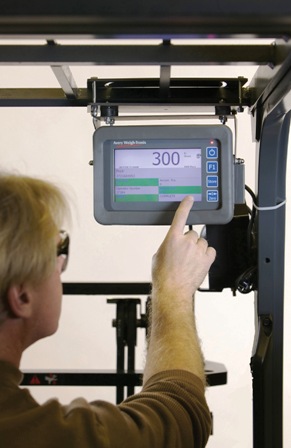
The first automated UK data management system for Forklift Truck Scales will improve process efficiency for lean operating and traceability for ISO 9002 or ISO 14000, claims Avery Weigh-Tronix. Using an optional Wi-Fi link, data from the forklift scale transfers to a back office system in real time.
Says Chris McAllister, product manager for Avery Weigh-Tronix: "Many people understand the advantages of using a forklift scale to lift, weigh and move loads in one operation. To further improve efficiency and to provide a traceable audit trial, an organisation must improve the way that the data is captured, recorded and then used."
"In today's climate the days of using a piece of paper to record weight and then inputting this into a PC later is simply not good enough. In an era of cost down and lean operating, data is vital and you cannot afford human error. Our system can capture, store and transfer the information to a back office system automatically."
Available with the Avery Weigh-Tronix forklift truck scale, the FLI 425 in cab indicator has a windows CE.NET platform and a 7" touch screen colour LCD display. It offers four data capture options, a standard configuration, a counting application, checkweighing or a data manager solution. All four options can be accessed via the touch screen menu.
After collecting and recording weight and other data, the FL 425 can transfer it in several ways: by serial ports, using a USB memory stick, by Ethernet, using a Wi-Fi link or via Bluetooth. The system will store up to 2000 transactions until the data transfers to a PC or other back office system.
Using the data manager option, a database can be configured on a PC and then downloaded automatically onto a fleet of forklift trucks. Several parameters can be set and changed in the future if needed. A series of drop down menus from the touch screen will guide the driver through the process.
Once the PC or back office system receives this information, the organisation can access and use it however they choose. It can for example trace the number of transactions, how much has been moved and where in total or by individual load, who moved it, the date and time of transaction, which goods are moved most frequently and of course the actual weight compared to estimated weight.
Says McAllister: "Our aim is to make the collection of data simple and then allow the customer to make maximum use of this information. In today's market information is king, both for an organisation to improve its efficiency and for auditable traceability."
As an alternative the standard application provides a simple solution for compiling a manifest of goods. It can store up to 15 configurable fields. Here the data collected would include the operator ID, the forklift truck used, the job number, a description of the load, the estimated and actual weight, the date and time that the load was moved and weighed, and the department. This information can be transferred to the back office as an excel spreadsheet.
In the counting application, the forklift scale will record the number of items moved using weight. If the operator knows the quantity of items lifted then the system will calculate the weight of a single unit. Alternatively if an item's weight is known, then the number off items lifted is calculated.
Finally the checkweighing application allows operators to enter a target weight and tolerance before they take the actual weight. The scale will then record the actual weight and show whether the load is within the target range or is under or over weight. If the load is over or under the target then an audible or visual warning will alert the driver.
The checkweighing function can also be used for filling a container to a target weight. Again an audible or visual warning will alert the driver when it is full.
For organisations wanting a simpler solution, Avery Weigh-Tronix also offers the FL 225 indicator. This has three standard operating modes, classic with print, classic with accumulation and an expanded version. It can provide a category 3 audit trail, has two RS-232 interfaces and stores up to 350 transactions.
Says McAllister: "Most forklift truck scales simply weigh. This simply does not provide enough information for most organisations. Automating the process saves man hours and avoids human error."